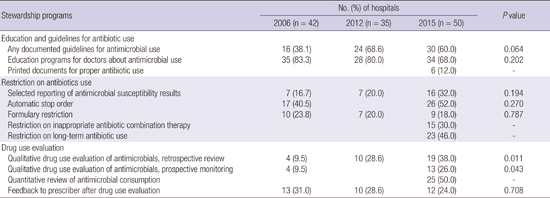1. Spellberg B, Guidos R, Gilbert D, Bradley J, Boucher HW, Scheld WM, Bartlett JG, Edwards J Jr; Infectious Diseases Society of America. The epidemic of antibiotic-resistant infections: a call to action for the medical community from the Infectious Diseases Society of America. Clin Infect Dis. 2008; 46:155–164.
2. Boucher HW, Talbot GH, Bradley JS, Edwards JE, Gilbert D, Rice LB, Scheld M, Spellberg B, Bartlett J. Bad bugs, no drugs: no ESKAPE! An update from the Infectious Diseases Society of America. Clin Infect Dis. 2009; 48:1–12.
3. Giske CG, Monnet DL, Cars O, Carmeli Y. ReAct-Action on Antibiotic Resistance. Clinical and economic impact of common multidrug-resistant gram-negative bacilli. Antimicrob Agents Chemother. 2008; 52:813–821.
4. Roberts RR, Hota B, Ahmad I, Scott RD 2nd, Foster SD, Abbasi F, Schabowski S, Kampe LM, Ciavarella GG, Supino M, et al. Hospital and societal costs of antimicrobial-resistant infections in a Chicago teaching hospital: implications for antibiotic stewardship. Clin Infect Dis. 2009; 49:1175–1184.
5. MacDougall C, Polk RE. Antimicrobial stewardship programs in health care systems. Clin Microbiol Rev. 2005; 18:638–656.
6. Bang JH, Song KH, Park WB, Kim SH, Cho JH, Kim HB, Kim NJ, Oh M, Choe KW. A survey on antimicrobial prescriptions and stewardship programs in Korea. Infect Chemother. 2006; 38:316–324.
7. Kim HI, Kim SW, Chang HH, Kim HB. A survey of antimicrobial stewardship programs in Korean hospitals. Korean J Med. 2014; 87:173–181.
8. Dellit TH, Owens RC, McGowan JE Jr, Gerding DN, Weinstein RA, Burke JP, Huskins WC, Paterson DL, Fishman NO, Carpenter CF, et al. Infectious Diseases Society of America and the Society for Healthcare Epidemiology of America guidelines for developing an institutional program to enhance antimicrobial stewardship. Clin Infect Dis. 2007; 44:159–177.
9. Kim JY, Jo YM, Choi WS, Yoon YK, Jeong HW, Park DW, Sohn JW, Kim YM, Kim MJ. Usefulness of computerized restricted antibiotics use and control program in a tertiary care hospital. Infect Chemother. 2006; 38:235–241.
10. Evans RS, Pestotnik SL, Classen DC, Clemmer TP, Weaver LK, Orme JF Jr, Lloyd JF, Burke JP. A computer-assisted management program for antibiotics and other antiinfective agents. N Engl J Med. 1998; 338:232–238.
11. Wilf-Miron R, Ron N, Ishai S, Chory H, Abboud L, Peled R. Reducing the volume of antibiotic prescriptions: a peer group intervention among physicians serving a community with special ethnic characteristics. J Manag Care Pharm. 2012; 18:324–328.
12. Davey P, Brown E, Charani E, Fenelon L, Gould IM, Holmes A, Ramsay CR, Wiffen PJ, Wilcox M. Interventions to improve antibiotic prescribing practices for hospital inpatients. Cochrane Database Syst Rev. 2013; CD003543.
13. Song YJ, Kim M, Huh S, Lee J, Lee E, Song KH, Kim ES, Kim HB. Impact of an antimicrobial stewardship program on unnecessary double anaerobic coverage prescription. Infect Chemother. 2015; 47:111–116.
14. Goff DA, Bauer KA, Reed EE, Stevenson KB, Taylor JJ, West JE. Is the “low-hanging fruit” worth picking for antimicrobial stewardship programs? Clin Infect Dis. 2012; 55:587–592.
15. Stevenson KB, Balada-Llasat JM, Bauer K, Deutscher M, Goff D, Lustberg M, Pancholi P, Reed E, Smeenk D, Taylor J, et al. The economics of antimicrobial stewardship: the current state of the art and applying the business case model. Infect Control Hosp Epidemiol. 2012; 33:389–397.
16. Johannsson B, Beekmann SE, Srinivasan A, Hersh AL, Laxminarayan R, Polgreen PM. Improving antimicrobial stewardship: the evolution of programmatic strategies and barriers. Infect Control Hosp Epidemiol. 2011; 32:367–374.
17. Oh JT, Kim SW, Son JW, Do BH, Han SW, Shin BC, Park JH, Lee JM, Kim NS. The effect of aminoglycoside restriction on the resistance pattern and mortality of nosocomial bacteremia caused by gram-negative bacilli. Infect Chemother. 2003; 35:192–198.
18. Aubert G, Carricajo A, Vautrin AC, Guyomarc’h S, Fonsale N, Page D, Brunel P, Rusch P, Zéni F. Impact of restricting fluoroquinolone prescription on bacterial resistance in an intensive care unit. J Hosp Infect. 2005; 59:83–89.
19. Allegranzi B, Luzzati R, Luzzani A, Girardini F, Antozzi L, Raiteri R, Di Perri G, Concia E. Impact of antibiotic changes in empirical therapy on antimicrobial resistance in intensive care unit-acquired infections. J Hosp Infect. 2002; 52:136–140.
20. Yoon YK, Park GC, An H, Chun BC, Sohn JW, Kim MJ. Trends of antibiotic consumption in Korea according to national reimbursement data (2008-2012): a population-based epidemiologic study. Medicine (Baltimore). 2015; 94:e2100.








 PDF
PDF ePub
ePub Citation
Citation Print
Print





 XML Download
XML Download